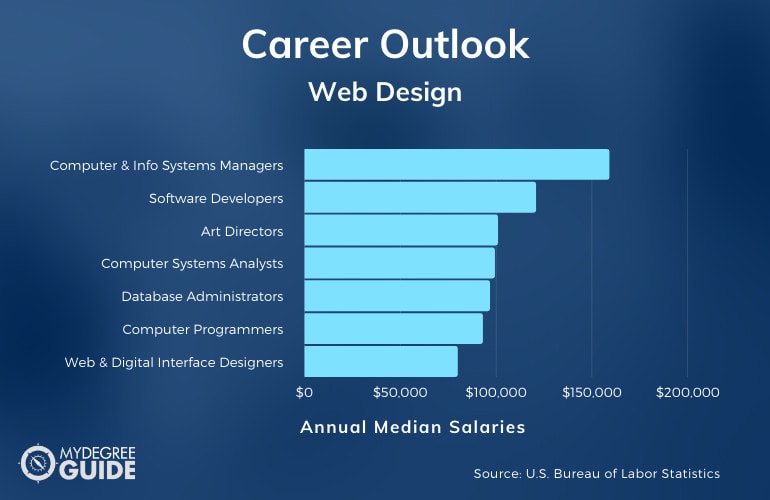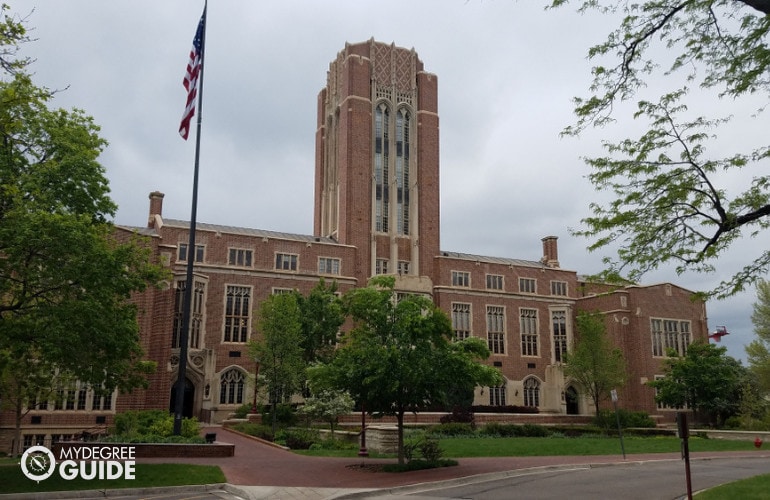A masters in web design online program can hone your skills in creating effective and beautiful interfaces for digital products.

Technology is one of the most profitable and fastest growing industries today, and a masters in the field can help you advance your qualifications. Web design is an in-demand skill, with plenty of opportunities for job growth and career freedom.
Editorial Listing ShortCode:
If you’re passionate about using your visual creativity to help build innovative websites and apps, then earning an online masters in web design might be a strategic next step.
Universities Offering Online Masters in Web Design Degree Program
Methodology: The following school list is in alphabetical order. To be included, a college or university must be regionally accredited and offer degree programs online or in a hybrid format.
Arizona State University
Arizona State University offers a Master of Science in Graphic Information Technology. It aims to help students harness their creative abilities and deepen their understanding of the graphic design field. The program consists of 10 classes for a total of 30 credits. Each class can be completed fully online and is usually 7.5 to 15 weeks long.
Arizona State University is accredited by the Higher Learning Commission of the North Central Association of Colleges and Schools.
Harvard University
Harvard University offers a Master’s in Digital Media Design. The curriculum includes studies in cutting edge production methods and the utilization of the latest design technology and opportunities to apply these studies in hands-on experiences. Students can also add several certifications in skills like web technologies or back-end web development to their degrees.
Harvard University is accredited by the New England Commission of Higher Education.
Illinois Institute of Technology
Illinois Institute of Technology offers a Master of Sciences in Information Technology and Management. It is designed for those pursuing careers in data analysis, digital systems architecture, information systems management, or software and application development. The core curriculum consists of 30 credits. After completing these, students can select one of 9 specialties.
Illinois Institute of Technology is accredited by the Higher Learning Commission.
Minneapolis College of Art and Design
Minneapolis College of Art and Design offers a Master of Arts in Graphic and Web Design. The curriculum offers studies in theoretical design and the opportunity to build an extensive portfolio of work in print, digital, and web platforms. This 30 credit program is housed entirely online, allowing students to pursue their education wherever they wish and at their own pace.
MCAD is accredited by the Higher Learning Commission.
Quinnipiac University
Creative, visual, and critical thinking skills are at the core of the Master of Science in Interactive Media and Communications program at Quinnipiac University. The program combines the flexibility of online learning and a world-class curriculum that aims to educate students in design principles and processes that tell stories and improve others’ lives.
Quinnipiac is accredited by the New England Commission of Higher Education.
Southern New Hampshire University
Southern New Hampshire University offers an online, 36 credit Master’s in Information Technology program. It aims to help students develop in-demand skills that combine information technology, design, and management. Students can customize their curriculum according to their interests. They can specialize in Data Analytics, Web Design, Software Development, Database Design, Informatics, or Information Security.
Southern New Hampshire University is accredited by the New England Commission of Higher Education.
Touro University
Touro University offers a Master of Arts in Web and Multimedia Design. The curriculum focuses on multi-media production, user experience and interface design, graphic design, and 2D and 3D modeling. Students can attend online or in-person, and core courses cover topics such as design thinking, responsive web development, and interactive design for web and mobile.
Touro University is accredited by the Middle States Commission on Higher Education.
University of Denver
The University of Denver offers a Master’s in Information and Communication Technology with a concentration in Web Design and Development. The curriculum is designed to help students develop foundational knowledge in web design, user experience, and information technology. Each class is 10 weeks long, and most students can complete this online program in 18 months.
The University of Denver is accredited by the Higher Learning Commission.
University of Florida
The University of Florida offers a Master of Arts in Mass Communication with a concentration in Web Design. The curriculum emphasizes student mastery of design skills, communication theory, and coding. The program consists of 37 credits, all of which can be completed online in as little as 16 months.
The University of Florida is accredited by the Southern Association of Colleges and Schools Commission on Colleges.
Wilmington University
The Master of Science in Information Systems Technology program at Wilmington University can be completed fully online. The curriculum consists of 15 credits of core curriculum and 18 credits in the student’s specialty. Core courses include Data Management, Data Communications, Project Management, IT Policy, and Analysis, Modeling, and Design.
Wilmington University is accredited by the Middle States Commission on Higher Education.
Online Masters in Web Design Programs

In a web design masters program, you’ll specialize in planning the visual elements of a website, from coming up with the layout to adding interactivity through animations and videos. Web designers need to have a broad range of skills since they often juggle several tasks.
Here are some of the common responsibilities of a web designer:
- Communicate with clients to understand their needs
- Put together a design that incorporates icons, fonts, and other graphics
- Create wireframes and mockups using software tools
- Understand users’ behaviors and needs to make user-friendly designs
- Collaborate with developers, graphic designers, and other team members
- Adjust designs based on user feedback, client requests, and analytics
Aside from being visually creative, web designers often need to be familiar with psychology and marketing. It’s helpful to have at least basic proficiency in web development using HTML, CSS, and JavaScript. Web design master’s programs are often very thorough, with a project-based approach. By the end of the program, you’ll have built a professional portfolio.
There are many types of graduate degrees in web design. One of the most popular degrees is a master’s in web design and interactive media, where you can explore digital products like videos, games, and virtual reality in addition to websites and apps.
Another common specialization is web design and development. With this track, you can learn how to build a website on your own and explore full-stack web development with languages such as Node.js, SQL, and PHP.
Web designers can also pursue a graduate program in user experience design, or UX design. UX design involves creating products that are practical, usable, and meaningful for users. Aside from graphic design, this involves carrying out usability tests and doing extensive user research.
Depending on your specialization, a graduate degree in web design can prepare you for various roles. Some professionals work as web developers, digital designers, or even product managers. Graduates tend to join the product team of technology companies, work for design and marketing studios, or set up their own business as freelancers and consultants.
Website Design and Development Careers & Salaries

There are many career paths available to professionals who hold a masters in web design and development, depending on their area of specialization.
Graduates typically apply their design skills in the technology field, with roles such as web designer, user interaction (UI) designer, and data visualization specialist. Alternatively, some become user experience (UX) designers who also test usability and study customer behavior.
According to the Bureau of Labor Statistics, here are some careers related to web design and development, along with their median salaries.
| Careers | Annual Median Salaries |
| Computer and Information Systems Managers | $159,010 |
| Software Developers | $120,730 |
| Art Directors | $100,890 |
| Computer Systems Analysts | $99,270 |
| Database Administrators | $96,710 |
| Computer Programmers | $93,000 |
| Web and Digital Interface Designers | $79,890 |
| Special Effects Artists and Animators | $78,790 |
| Web Developers | $77,030 |
| Graphic Designers | $50,710 |
Since web design programs often include courses on web development, some graduates branch out into becoming developers rather than designers. Related job roles include computer programmer, web developer, and computer systems analyst.
Many web design graduates start out as front-end developers who translate designs into a visible website using code. Web design and development are essential for most organizations, so graduates can also join companies in industries outside of the technology sector.
It’s possible for graduates to venture into graphic design, marketing, or even product management after at least a few years of experience.
Web Design Master’s Degree Curriculum

A master’s in web design program will usually feature some core classes, with the rest of the program consisting of electives that you’ll choose. Here is a sample of common classes:
- Programming for Web Design: This course gives you a foundation in front-end web development, with the goal of developing your ability to create dynamic webpages.
- Web Design Principles: You’ll learn about designing visually pleasing digital interfaces, from icons and illustrations to typography, and you’ll also study the information architecture to back it up.
- User Experience Design: This course teaches you about the entire process of making user-centered products, which includes research, wireframing, and user testing.
- User Experience Research: You’ll get to know about different techniques for understanding user motivation and behavior, such as interviews and surveys.
- Branding on the Web: This course studies how to develop brand identities and style guides for both individuals and organizations and then apply them to websites.
- Visual Communication: You’ll delve into design principles such as layout, illustration, and color to hone your visual literacy while exploring different types of media.
- Responsive Web Development: This course focuses on how to design and develop websites that provide a great user experience across several platforms, including mobile, web, and tablet.
- Prototyping: To test your designs, you’ll practice creating various kinds of prototypes—such as mock-ups, wireframes, and working models—using industry-standard tools.
- Designing for Usability: A hallmark of great web design is usability, so you’ll explore cognitive psychology topics, such as visual perception and attention, to understand how users think.
- Design Thinking: This course teaches you how to do creative problem-solving, test various business models, and come up with innovative products.
A web design master’s program usually culminates in a capstone project, where you’ll generally build a portfolio and create designs for actual websites.
Admissions Requirements

Most web design masters programs ask for the following admissions criteria:
- Official transcripts. You’ll submit transcripts for all college and postgraduate classes you’ve taken.
- Resume or CV. Schools typically want to know about your professional experience in design and technology.
- Portfolio. This can include case studies, wireframes, and projects you’ve worked on.
- Statement of purpose. Your statement of purpose or intent is where you explain your reasons for wanting to study web design.
- Recommendation letters. These are typically written by former or current supervisors, clients, and professors.
Some schools also require GRE or GMAT scores, but this is less common with design programs.
Web Design Graduate Programs Accreditation

Accreditation is a top consideration when choosing a web design graduate program. To receive regional accreditation, a school has to satisfy several strict criteria, such as having high-quality coursework, qualified staff, and positive graduation rates.
The US Department of Education’s website has a list of accredited schools in the country. Attending an accredited program gives you the assurance that you’ll be receiving a high-quality education, and it can also be an eligibility factor for federal financial aid.
It may even increase your employability since many companies are more trusting of graduate degrees that come from accredited schools.
Financial Aid and Scholarships

Most graduate students explore various financial aid options to see if they can qualify for tuition assistance. The most sought-after forms of financial aid are grants and scholarships because they don’t have to be repaid. They’re usually merit-based, but some are awarded based on financial need.
Other options include graduate assistantships as well as employer tuition assistance. You can also look into low-interest student loans, which you’d pay back after graduating. To apply for federal aid, such as loans, grants, and work-study programs, you can fill out the Free Application for Federal Student Aid (FAFSA).
Should I Get a Masters in Web Design Degree?

A masters in web design can lead to opportunities in the thriving tech industry, but whether or not this graduate degree is right for you depends on your personal interests and career goals.
Computer and information technology jobs are increasing every year, with most businesses and organizations having websites that need regular maintenance and updating. On top of this, the salaries of many web design and development jobs tend to be higher than average.
A master’s degree can help you upgrade your skills, expand your portfolio, and gain advanced credentials for professional growth.
What Can I Do with a Master Degree in Web Design?

A masters degree in website design can train you in the industry’s best practices for designing and building websites. A graduate degree in this field could also help you qualify for advanced roles.
There are more design jobs than ever in technology, including user experience design, interaction design, and web design. Demand will only increase as businesses become more reliant on digital products. Some graduates focus on coding instead, pursuing roles such as web developer, software programmer, and systems analyst.
As professionals build up experience, they may eventually become design leads, product managers, or art directors.
Is Web Design Hard?

Web design’s level of difficulty is subjective, usually depending on your interests and abilities. Web design requires proficiency in several skill sets. Since the field is constantly evolving, web designers need to be learning constantly to keep up with changes. If you’re interested in web design and dedicated to keeping up with industry innovations, becoming a professional web designer can be a rewarding career path.
The most fundamental skills needed are visual literacy and a sharp eye for design. It’s also necessary to understand how websites work in general and to be comfortable with using various software tools. Aside from these, it’s beneficial to learn some basic coding while continuously updating your skills.
How Long Does It Take to Get a Masters in Web Design Online?
You can generally complete a web design masters degree online in 1 to 2 years if you’re a full-time student. For programs that consists of 36 credit hours or less, you might even be able to finish in 1 year with year-round enrollment.
Web design programs tend to be project-based, with plenty of time spent working on designs outside of classes. Any additional requirements, such as internships or capstone projects, may extend your time to completion. Studying part-time is common for working professionals, especially for online programs, though part-time enrollment will often take you longer to earn your degree.
What’s the Difference Between an Online Masters Degree in Web Design vs. Web Development?
Web design and web development are interrelated, but they can be delegated to different professionals.
| Web Design | Web Development |
|
|
In the website creation process, a web designer generates mockups, which are then passed on to a web developer who builds the website. There are some professionals who take care of the entire process.
Is a Masters in Web Design Degree Worth It?

Yes, a masters in web design degree is worth it for many professionals. According to the Bureau of Labor Statistics, the computer and information technology industry is growing faster than average, with 13% job growth expected over the next ten years.
There is rising demand for web developers and designers specifically, as companies are increasingly using digital products and services such as websites, social media, and e-commerce. Plus, many digital design jobs offer higher than average salaries, with your rates often able to increase as you gain experience and advance your professional qualifications.
Getting Your Web Design Masters Online

With a web design master’s degree, you have the opportunity to deepen your expertise in creating aesthetically pleasing, user-friendly websites that meet customer needs.
Web designers can have a great deal of freedom in this growing field. Your creativity can also be constantly stimulated, especially since there are often new software tools, products, and coding frameworks being introduced. An online master’s degree in web design can typically offer more flexibility, with choices of credible, accredited web design degree programs from all over the country.
You can start exploring accredited web design masters degrees today to find the program and specialization that best aligns with your interests and aspirations.
